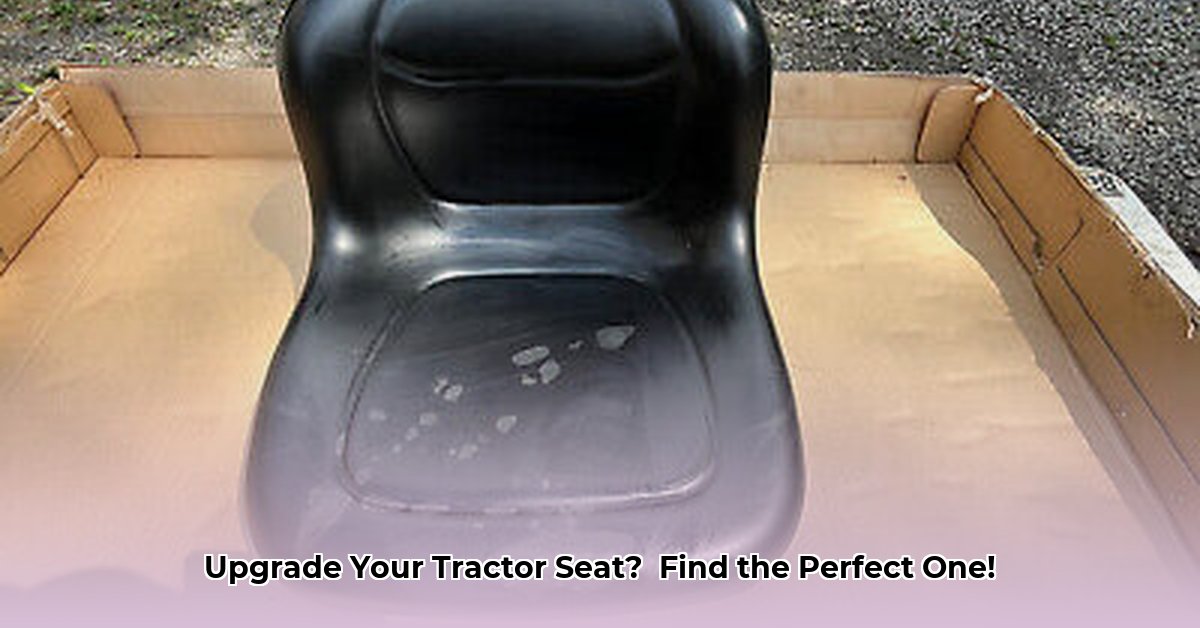
Finding the Right Craftsman Tractor Seat: A Step-by-Step Guide
Dealing with a worn-out Craftsman tractor seat? Replacing it is easier than you think! This guide provides a step-by-step process for finding the perfect replacement and installing it yourself. We'll cover everything from measuring your old seat to troubleshooting installation issues, ensuring you get back to work comfortably and efficiently. For more advanced tractor information, check out this helpful resource: Craftsman Tractor Info.
Measuring Your Old Seat: The Foundation of a Successful Replacement
Accurate measurements are crucial for finding a perfectly fitting replacement. Grab a tape measure and follow these steps:
- Seat Width: Measure the widest point of your current seat.
- Seat Depth: Measure from the front to the back edge.
- Seat Height: Measure from the bottom to the top.
- Mounting Holes: Measure the distance between each mounting hole and note their pattern (straight line, staggered, etc.). Sketching this is helpful.
- Base Shape: Note the overall shape of the seat base (flat, curved, etc.).
Remember, precision is key! Take multiple measurements to ensure accuracy. A small mistake here can lead to a poor fit.
Locating Your New Craftsman Tractor Seat: Exploring Your Options
Armed with your measurements, let's find your perfect replacement. Consider these options:
- Craftsman Website (1): Check the official Craftsman website for exact replacements. This is often the best place to start.
- Online Marketplaces (Amazon, eBay): These offer a wide selection of Craftsman and aftermarket seats, with varying prices and customer reviews. Read reviews carefully; they offer invaluable insights.
- Local Dealers: Visit local farm supply stores or agricultural retailers. They often carry parts and can provide personalized advice. This allows for hands-on inspection.
Don't be afraid to explore aftermarket options; they often offer improved features or better value.
Choosing Your Seat: Key Factors to Consider
Selecting the right seat involves balancing comfort, durability, and budget. Here's a comparison to help:
| Feature | Considerations |
|---|---|
| Comfort | Padding thickness, material (vinyl, fabric), backrest support, adjustability. |
| Durability | Frame material (steel is stronger than plastic), stitching quality. |
| Adjustability | Height, tilt, and slide adjustments enhance comfort and posture. |
| Mounting | Ensure mounting holes align with your tractor's mounting points. |
| Price | Compare prices across different sources; the cheapest option isn't always best. |
Did you know that a comfortable seat can significantly improve your work efficiency and overall enjoyment? Investing in a quality replacement is a worthwhile endeavor.
Installing Your New Craftsman Tractor Seat: A User-Friendly Guide
Installing your new seat is typically straightforward. Follow these steps:
- Removing the Old Seat: Carefully detach the old seat, noting how it was secured. Take photos for reference during reassembly.
- Cleaning the Mounting Area: Thoroughly clean the mounting area to ensure a secure fit.
- Attaching the New Seat: Align the new seat with the mounting points and secure it using the provided hardware. Consider reusing your old hardware if it's in good condition.
- Testing Your New Seat: Adjust the seat to your preferred position and ensure it's stable and secure. Test drive your tractor to verify everything is working as expected.
This process typically takes around 30-45 minutes, depending on your experience level.
Troubleshooting Common Installation Problems: Addressing Potential Issues
Here are solutions to common issues:
- Seat Doesn't Fit: Double-check your measurements. Even small errors can create significant problems.
- Mounting Problems: Ensure the mounting holes align perfectly. You may need shims (thin spacers) if necessary, but only if you are comfortable with this adjustment.
- Loose Seat: Verify all bolts and screws are tightly secured, but avoid over-tightening.
If problems persist, consult your tractor's owner's manual or seek help from a qualified mechanic.